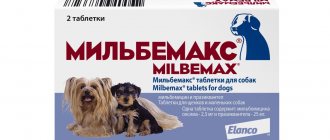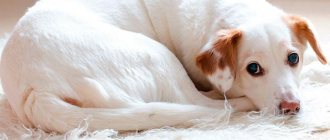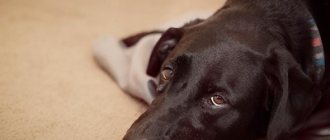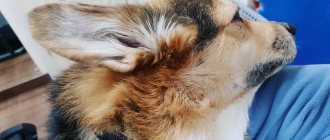Malassezia in dogs - what is it, routes of infection
Malassezia is a yeast-like fungus that lives on the surface of the skin, including in the ear canal of dogs . Being commensals, under normal conditions these microorganisms do not cause trouble, however, they are of no benefit either.
Colonization by this fungus occurs during the first contact of the puppy with its mother after birth.
If one dog has an overgrowth of Malassezia, then it cannot infect other individuals, including humans.
The causes of dermatitis and otitis are a violation of the integrity of the skin, its diseases. Malassezia is always a secondary infection to the underlying disease.
General information
This is the name for inflammation of the ears caused by fungi . Oddly enough, but not in all cases these mushrooms belong to pathogenic varieties. Much more often, the situation is like this: first, for some reason, the animal’s immune system sharply drops, as a result of which its body can no longer repel attacks from the outside, and only then the rapid development of fungi begins. Note that this phenomenon is a common consequence of long-term, thoughtless and uncontrolled administration of anti-inflammatory corticosteroids. They greatly impair the immune system.
The course and symptoms of the disease with photographs
The course of the disease can be acute or chronic. It all depends on how quickly the owners noticed the problem and took their pet to the doctor.
The main symptoms of Malassezia dermatitis:
- Itching;
- Redness of the skin, its thickening;
- A yellowish coating and moisture may appear on the dermal surface;
- Brownish or black discharge is observed in the skin folds and at the base of the claw;
- The claw itself can also change color to dark;
- Unpleasant odor from the skin and external auditory canals;
- There is a dark brown, ointment-like discharge in the ears.
It should be noted that with otodectosis - ear scabies, the discharge will often be black, dry, and flakes.
Also read an important article on the topic: “The main types of dermatitis in dogs and their treatment.”
Clinical picture of the disease
Otitis is divided into three types: external, intermediate and deep ( internal ). Note that the difference between these options is sometimes very blurry. Thus, otitis externa, which, “hypothetically,” only implies damage to the auricles and the external ear canal itself, can very quickly “grow” into otitis media. In addition, the infection quickly goes down, which is why a dog suffering from inflammation of only the ears has a good chance of going deaf from the destruction of the eardrum.
Otitis is also divided into unilateral and bilateral . This is all clear - only one ear becomes inflamed, or both at once. But! There are noticeably fewer cases of unilateral otitis media. As a rule, the infection (with the help of an animal scratching its ears) quickly penetrates into the second ear.
What are the symptoms of the disease? Firstly, irritation appears on the skin lining the outside of the ear canal. The animal is not at all happy about this, it becomes restless and begins to constantly scratch its ears . This only intensifies the inflammatory process, which causes the pet a lot of suffering and inconvenience. In particular, due to the unpleasant sensations, the dog scratches hard and bleeds and even tears his ears.
This is very easy to notice, since the ears are completely covered with scabs and crusts of dried blood. In addition, inflammation can be detected by an extremely unpleasant or even disgusting odor emanating from your pet's head.
But all the clinical signs described above are characteristic mainly of the most harmless form of otitis – external. The middle and inner varieties manifest themselves much brighter and noticeably heavier. In particular, your pet becomes very painful. The dog often whines, growls, and does not allow himself to be scratched behind the ear. The pet becomes lethargic, eats poorly or completely loses its appetite.
In severe and advanced cases, fibrosis may develop , that is, the proliferation of connective tissue. Sometimes you can see that the diameter of the external auditory canals has decreased significantly. And this is just the beginning, since overgrown scar tissue can completely block the lumen of the canals. Such a “gift” to fungi is only beneficial, since ideal conditions are created inside the “clogged” ear canal for their growth and development, as a result of which the course of the disease greatly worsens.
The itching and pain intensify so much that the pet can no longer sleep normally. This causes the animal to become very irritable, and signs of exhaustion gradually increase. Some dogs even turn into “inadequate” dogs and can bite anyone (even the owner) if he tries to simply touch their head, not to mention their ears. When the disease has developed to this extent, the only way out is to immediately take your pet to the veterinarian, as only he can help keep the animal alive and healthy.
But severe fungal otitis of the deep type can go even further. The fact is that mushrooms, growing, begin to destroy the tissues surrounding them. With deep otitis media, this leads to the fact that the eardrum and even the vestibular apparatus may be, if not destroyed, then seriously damaged. The first sign of something completely wrong is the sudden appearance of deafness, which can be either unilateral or bilateral.
In addition, severe pain leads to the dog sitting for a long time with his head tilted to one side. Torticollis may develop. But this is not the worst thing. It’s much worse that deep fungal otitis media often leads to damage to the nervous system . The signs are quite characteristic - the animal’s gait becomes “wooden”, the pet’s movements are uncoordinated, the dog will constantly bump into furniture and people. With severe damage to the central nervous system (CNS), neurological seizures develop, the dog may fall into a coma, the chances of recovery from which are almost zero.
Diagnostics
Symptoms of the presence of Malassezia fungus are not always characteristic; infectious agents in the form of bacterial microflora may also be attached.
In this regard, it is not recommended to self-medicate; you should consult a dermatologist for diagnosis.
Malassezia is quite easy to detect:
- To do this, you need to take a smear from the skin or from the external auditory canal;
- Apply a thin layer of the resulting material onto a glass slide;
- Paint with special dyes;
- Examine under a microscope.
As you understand, this should be done by a veterinarian.
Photo of Malassezia fungus under a microscope
Under a microscope, Malassezia is clearly visible; its shape resembles a tumbler. The colonies are located crowdedly. Normally, one or two fungi can be seen in one field of view; if more, then this is a pathology.
Malassezia in dogs how to treat
To treat a dog for Malassezia dermatitis and otitis, it is first necessary to eliminate factors favorable for reproduction and the root cause of overgrowth.
If we talk about Malassezia dermatitis, then depending on the location and extent of the lesions, both systemic and local drugs can be used.
Preparations for local treatment:
- Chlorexiderm foam or spray with 4% chlorhexidine.
- Shampoo with 4% chlorhexidine works well against fungi and relieves itching . Various manufacturers have it, for example, the American company Davis has products with chlorhexedine and miconazole. Russian companies, for example, Apicenna, also have similar shampoos.
- Liverazole may be effective . It helps cope with dermatophytes and other types of fungi.
- Lime Sulfur shampoo does not need to be rinsed off, but is not recommended for owners of dogs with light fur, as it can turn it yellowish. Lime sulfur also has an unpleasant odor, some compare it to rotten eggs. However, the product is very effective.
- Locally, you can use ointments with an antimycotic, for example, Ketoconazole .
- The spray is also suitable for local, shallow lesions, for example, Fungivet .
For diffuse dermatitis, systemic medications are used:
- If the root cause of fungal overgrowth is an allergic reaction, then a special therapeutic diet is additionally prescribed, for example, Hill's z/d or Hill's Prescription Diet Derm Defense .
- Drugs to eliminate allergy symptoms: Atopica, Cytopoint, Apoquel , or human tablets Prednisolone or Methylprednisolone .
- In some cases, antifungal tablets or capsules are prescribed: Terbinafine, Ketoconazole, Intraconazole .
Therapy can be long-term and last several weeks. The end of treatment occurs when no large quantities of Malassezia are detected in the control smears.
Normally, there are 1-2 fungal cells in one field of view. You should not interrupt the course of therapy on your own, since if the dog is not fully treated, the problem may return and get worse.
In the ears
When identifying fungal overgrowth in the ears, you should follow the following recommendations:
- It is necessary to ensure good ventilation of the ear canal and remove existing hair.
- For hyperplasia, that is, an increase in the volume of ear tissue, systemic anti-inflammatory drugs are used in a short course, for example, Prednisolone.
In some cases, it is enough to spray a veterinary medicine into the ear, Cortavance , which does not have a systemic effect, but will help “open” the ear.
- Clean the ears of discharge using a special lotion or 0.9% sodium chloride solution no more than once every 2 days.
- Special drops, as a rule, have a wide spectrum of action, not only against fungi, but also against bacteria. Surolan, Osurnia, Posatex are popular .
On my paws
It can be effective to use a 2% solution of table vinegar to treat lesions that are localized in the interdigital spaces or in the claw area.
Since it can be difficult to carry out the treatment efficiently, baths with vinegar for 5-10 minutes may be recommended. They will help control the growth of Malassezia, do not cause dependence and stability of the microflora.
Tablets are used if there is significant damage to the claws, or if ointments and shampoos do not give the desired effect.
Treatment at home
If otitis media is detected in dogs, how to treat it at home? At first, you can alleviate your pet’s condition at home.
As home measures you can use:
- If there is severe scratching, the inner surface of the ear is wiped with hydrogen peroxide and carefully dried with a gauze bandage. Scratches are lubricated with brilliant green.
- If pus has accumulated and the ear “squishes,” you should carefully clean it with boric alcohol, blot it dry and cover it with streptocide powder.
- Dark plaque can be caused by mites. In this case, the auricle is freed from wax accumulations and lubricated with phenothiazine.
Drops for the treatment of Malassezia fungus in dogs
| Name | Application diagram | approximate cost |
| Surolan , 15 ml | 3-5 drops 2 times a day for up to 15 days | 700 |
| Aurizon , 10 ml | 10 drops 1 time per day for up to 14 days | 800 |
| Bars forte , 10 ml | 3-5 drops 2 times a day for a week | 200 |
| Izotik , 10 ml | 1 ml in each ear once a day for 5 days | 1000 |
| Otoxolan , 10 ml | 5-10 drops 2 times a day for up to two weeks | 500 |
| Posatex , 8.8 ml | 2-8 drops 1 time per day for 7 days | 1200 |
Drugs for treating dogs
| Pills | Shampoos | Sprays | Ointments |
| Ketoconazole, 10 pcs 200-400 rubles | Chlorexiderm, 1500 rubles | Chlorexiderm, 1200 rubles | Clotrimazole, 300 rubles |
| Intraconazole, 14 pcs. 400 – 750 rubles | Apicena with chlorhexedine 4%, 350 rubles | Stop itching, 450 rubles | Miconazole, 200-500 rubles |
| Terbinafine, 14 pcs 250-450 rubles | Miconazole Davis, 200 ml 600 rubles | Fungin, 400 rubles | Terbinafine, 200 rubles |
| Chlorhexedine Davis, 200 ml 600 rubles | Fungivet, 300 rubles | Ketoconazole, 200-400 rubles | |
| Liverazol, 1000 rubles | Terbinafine 200 rubles | ||
| Lime sulfur, 850 rubles |
Methods for preventing the disease
Prevention of Malassezia dermatitis and otitis is to monitor the condition of your pet.
If the first signs of ear inflammation or changes in the skin occur, you must consult a veterinarian in order to make a timely diagnosis.
Preventive measures include:
- Drying the pet's skin, preventing a constant weeping effect. For example, dogs with a beard (schnauzers and others) should wipe their fur dry after drinking water.
- Particular attention should be paid to dogs of brachycephalic breeds . In them, Malassezia dermatitis often occurs in the area of skin folds of the muzzle, prepuce, vulva, and tail. You need to regularly inspect, wipe and dry the folds. Pioclin wipes are good for this purpose . You can also use a chlorhexedine solution, foam, or spray.
- If your dog is allergic or prone to skin problems, you can use vinegar baths for paws and bathe them with shampoo containing 4% chlorhexidine.
- If your pet has hair growing in its ears , it needs to be trimmed and removed.
- Dogs with floppy ears (spaniels, Labradors, basset hounds and others) should periodically open them to allow good air circulation.
Causes of ear fungus development
Microorganisms of fungal origin that provoke the development of otitis media in domestic animals are opportunistic.
They begin to actively grow and reproduce only in conditions favorable to them. Most often, otomycosis affects dog breeds with long ears, as well as during the hot period of the year, when the environment has a favorable effect on the development of yeast fungi.
There are many reasons for the development of otomycosis and the main ones are:
- inflammatory processes on the pet’s skin (as a result of a decrease in the protective properties of the skin);
- ear mites (a provoking factor for the appearance of otomycosis);
- allergic reactions in your pet to food and other foreign proteins;
- weakening of the body’s general defenses during pathological changes in internal organs;
- stressful situations;
- minor damage to the inside of the ear;
- prolonged and uncontrolled use of antimicrobial agents.
Veterinary experts strongly recommend that after taking any types of antibiotics, be sure to give the animal probiotics. The development of otomycosis of fungal etiology can also occur due to the use of hormonal-type anti-inflammatory drugs.
As a result of stopping the inflammatory process, corticosteroid drugs significantly weaken the body's defenses, provoking the development of fungal microorganisms.











